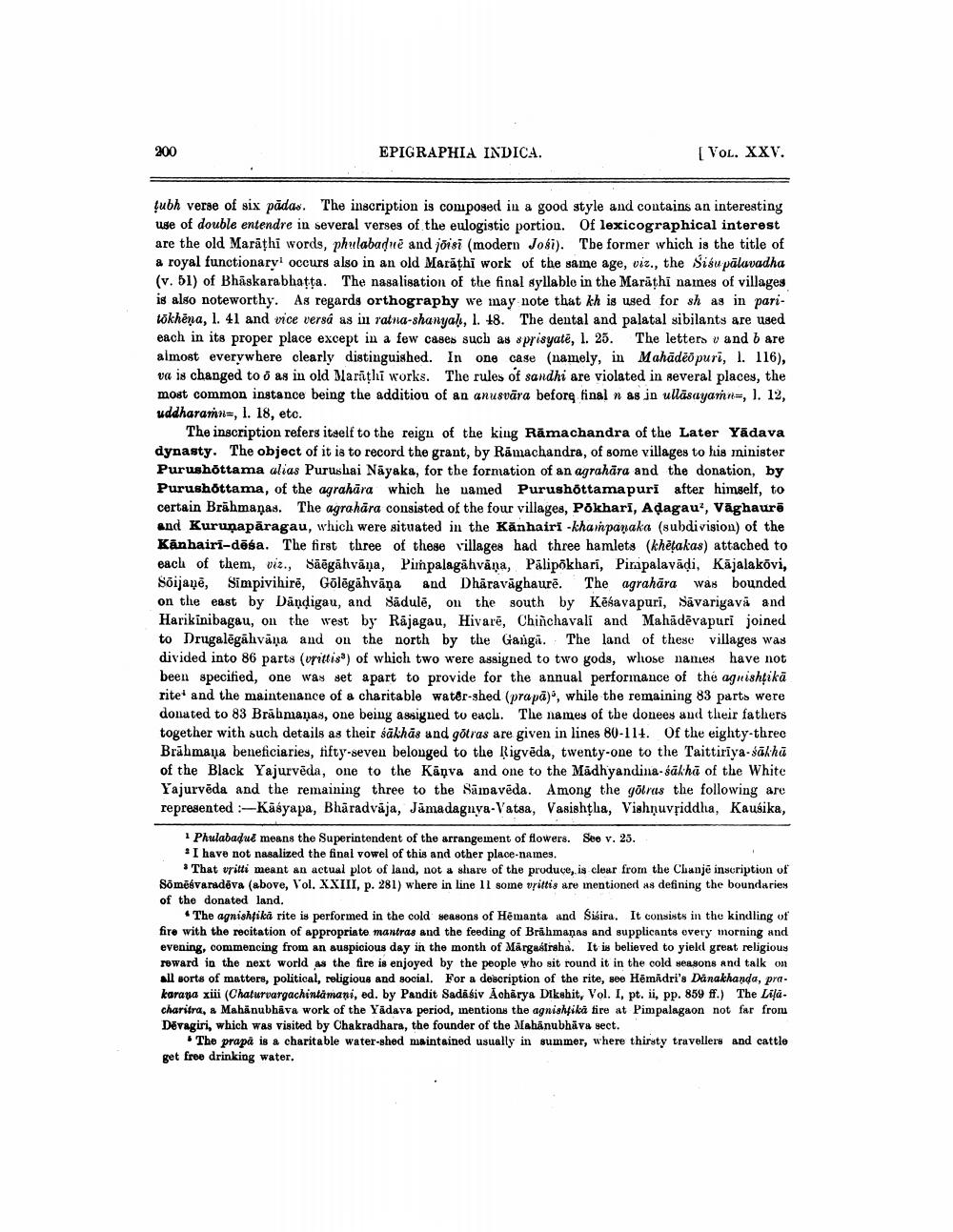________________
200
EPIGRAPHIA INDICA.
[VOL. XXV.
gubh verse of six pādas. The inscription is composed in a good style and contains an interesting use of double entendre in several verses of the eulogistic portion. Of lexicographical interest are the old Marāthi words, phulabadue and joisi (modern Joki). The former which is the title of a royal functionary occurs also in an old Marāțhi work of the same age, viz., the Sisu pālavadha (v. 51) of Bhāskara bhatta. The nasalisation of the final ayllable in the Marathi names of villages is also noteworthy. As regards orthography we may note that kh is used for sh as in paritokhēna, 1. 41 and vice versá as in ratna-shanyah, 1. 48. The dental and palatal sibilants are used each in its proper place except in a few cases such as sprisyatē, l. 25. The letters v and b are almost everywhere clearly distinguished. In one case (namely, in Mahādēópuri, 1. 116), va is changed to o as in old Marathi works. The rules of sandhi are violated in several places, the most common instance being the addition of an anusvāra before final n as in ullāsayamn=, 1. 12, uddharamn=, 1. 18, etc.
The inscription refers itself to the reign of the king Rāmachandra of the Later Yādava dynasty. The object of it is to record the grant, by Rāmachandra, of some villages to his minister Purushottama alias Purushai Näyaka, for the formation of an agrahāra and the donation, by Purushottama, of the agrahāra which he named Purushottamapuri after himself, to certain Brāhmaṇas. The agrahāra consisted of the four villages, Pokhari, Adagau, Vāghaurē and Kurunapăragau, which were situated in the Kanhairi -khampanaka (subdivision) of the Kanhairi-dēša. The first three of these villages had three hamlets (khēļakas) attached to each of them, viz., Sāēgāhvāņa, Pimpalagähvāņa, Pālipokhari, Piripalavādi, Kājalakovi, Sõijanē, Simpivihirē, Gõlēgāhvāna and Dharavāghaurē. The agrahāra was bounded on the east by Dāndigau, and Sadule, on the south by Kēšavapuri, Săvarigavă and Harikinibagau, on the west by Rājagau, Hivarē, Chinchavali and Mahādēvapuri joined to Drugalēgāhvāna and on the north by the Gangai. The land of these villages was divided into 86 parts (vrittiss) of which two were assigned to two gods, whose nanies have not been specified, one was set apart to provide for the annual performance of the agnishtikā rites and the maintenance of a charitable water-shed (prapa)', while the remaining 83 parts were donated to 83 Brāhmaṇas, one being assigued to each. The names of the donees and their fathers together with such details as their säkhās and gotras are given in lines 80-114. Of the eighty-three Brāhmaṇa beneficiaries, fifty-seven belonged to the Rigvēda, twenty-one to the Taittiriya-sākhū of the Black Yajurvēda, one to the Kāņva and one to the Madhyandina-śākhā of the White Yajurvēda and the remaining three to the Samavēda. Among the golras the following are represented :-Kasyapa, Bhāradvāja, Jāmadagnya-Vatsa, Vasishtha, Vishnuvsiddha, Kausika,
* Phulabadut means the Superintendent of the arrangement of flowers. See v. 25.
I have not nasalized the final vowel of this and other place-names,
* That vritti meant an actual plot of land, not a share of the produce, is clear from the Chanje inscription of Sõmēsvaradeva (above, Vol. XXIII, p. 281) where in line 11 some vrittis are mentioned as defining the boundaries of the donated land.
• The agnishtikā rite is performed in the cold seasons of Hệmanta and Sisira. It consists in the kindling of fire with the recitation of appropriate mantras and the feeding of Brāhmaṇas and supplicants every morning and evening, commencing from an auspicious day in the month of Märgastreha. It is believed to yield great religious reward in the next world as the fire is enjoyed by the people who sit round it in the cold seasons and talk on all sorts of matters, political, religious and social. For a description of the rite, see Hēmādri's Danakhanda, pra. karapa xiii (Chaturvargachintamani, ed. by Pandit Sadāśiv Acharya Dikshit, Vol. I, pt. ii, pp. 859 ff.) The Liļā charitra, a Mahānubhāva work of the Yadava period, mentions the agnishfika tire at Pimpalagaon not far from Dévagiri, which was visited by Chakradhara, the founder of the Mahanubhāva sect.
The prapå is a charitable water-shed maintained usually in summer, where thirsty travellers and cattle get free drinking water,




